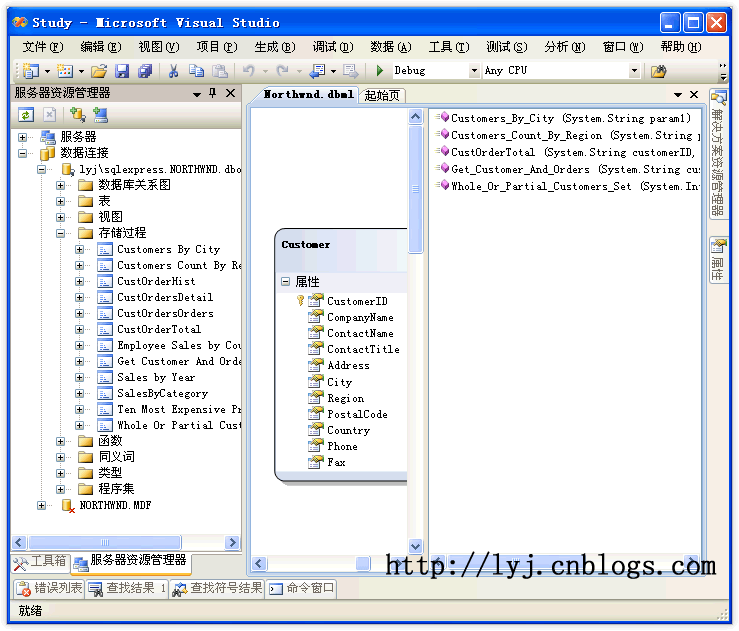Linq中使用存储过程作为结果集(转)
2014-04-28 09:50
281 查看
存储过程
在我们编写程序中,往往需要一些存储过程,在LINQ to SQL中怎么使用呢?也许比原来的更简单些。下面我们以NORTHWND.MDF数据库中自带的几个存储过程来理解一下。
我们只要把这个存储过程拖到O/R设计器内,它自动生成了以下代码段:
我们需要时,直接调用就可以了,例如:
语句描述:这个实例使用存储过程返回在“WA”地区的客户数。
下面的示例表示一个存储过程,该存储过程返回客户行并使用输入参数来仅返回将“London”列为客户城市的那些行的固定几列。
拖到O/R设计器内,它自动生成了以下代码段:
我们用下面的代码调用:
语句描述:这个实例使用存储过程返回在伦敦的客户的 CustomerID和City。
在下面的 SQL 代码示例中,结果形状取决于输入(param1 = 1或param1 = 2)。我们不知道先返回哪个投影。
拖到O/R设计器内,它自动生成了以下代码段:
但是,VS2008会把多结果集存储过程识别为单结果集的存储过程,默认生成的代码我们要手动修改一下,要求返回多个结果集,像这样:
我们分别定义了两个分部类,用于指定返回的类型。WholeCustomersSetResult类 如下:(点击展开)
代码在这里展开
这时,只要调用就可以了。
语句描述:这个实例使用存储过程返回客户“SEVES”及其所有订单。
下面的示例带有单个输入参数(客户 ID)并返回一个输出参数(该客户的总销售额)。
把这个存储过程拖到设计器中,图片如下:

其生成代码如下:
我们使用下面的语句调用此存储过程:注意:输出参数是按引用传递的,以支持参数为“in/out”的方案。在这种情况下,参数仅为“out”。
语句描述:这个实例使用返回 Out 参数的存储过程。
好了,就说到这里了,其增删改操作同理。相信大家通过这5个实例理解了存储过程。
在我们编写程序中,往往需要一些存储过程,在LINQ to SQL中怎么使用呢?也许比原来的更简单些。下面我们以NORTHWND.MDF数据库中自带的几个存储过程来理解一下。
1.标量返回
在数据库中,有名为Customers Count By Region的存储过程。该存储过程返回顾客所在"WA"区域的数量。ALTER PROCEDURE [dbo].[NonRowset] (@param1 NVARCHAR(15)) AS BEGIN SET NOCOUNT ON; DECLARE @count int SELECT @count = COUNT(*)FROM Customers WHERECustomers.Region = @Param1 RETURN @count END
我们只要把这个存储过程拖到O/R设计器内,它自动生成了以下代码段:
[Function(Name = "dbo.[Customers Count By Region]")]
public int Customers_Count_By_Region([Parameter
(DbType = "NVarChar(15)")] string param1)
{
IExecuteResult result = this.ExecuteMethodCall(this,
((MethodInfo)(MethodInfo.GetCurrentMethod())), param1);
return ((int)(result.ReturnValue));
}我们需要时,直接调用就可以了,例如:
int count = db.CustomersCountByRegion("WA");
Console.WriteLine(count);语句描述:这个实例使用存储过程返回在“WA”地区的客户数。
2.单一结果集
从数据库中返回行集合,并包含用于筛选结果的输入参数。 当我们执行返回行集合的存储过程时,会用到结果类,它存储从存储过程中返回的结果。下面的示例表示一个存储过程,该存储过程返回客户行并使用输入参数来仅返回将“London”列为客户城市的那些行的固定几列。
ALTER PROCEDURE [dbo].[Customers By City] -- Add the parameters for the stored procedure here (@param1 NVARCHAR(20)) AS BEGIN -- SET NOCOUNT ON added to prevent extra result sets from -- interfering with SELECT statements. SET NOCOUNT ON; SELECT CustomerID, ContactName, CompanyName, City from Customers as c where c.City=@param1 END
拖到O/R设计器内,它自动生成了以下代码段:
[Function(Name="dbo.[Customers By City]")]
public ISingleResult<Customers_By_CityResult> Customers_By_City(
[Parameter(DbType="NVarChar(20)")] string param1)
{
IExecuteResult result = this.ExecuteMethodCall(this, (
(MethodInfo)(MethodInfo.GetCurrentMethod())), param1);
return ((ISingleResult<Customers_By_CityResult>)
(result.ReturnValue));
}我们用下面的代码调用:
ISingleResult<Customers_By_CityResult> result =
db.Customers_By_City("London");
foreach (Customers_By_CityResult cust in result)
{
Console.WriteLine("CustID={0}; City={1}", cust.CustomerID,
cust.City);
}语句描述:这个实例使用存储过程返回在伦敦的客户的 CustomerID和City。
3.多个可能形状的单一结果集
当存储过程可以返回多个结果形状时,返回类型无法强类型化为单个投影形状。尽管 LINQ to SQL 可以生成所有可能的投影类型,但它无法获知将以何种顺序返回它们。 ResultTypeAttribute 属性适用于返回多个结果类型的存储过程,用以指定该过程可以返回的类型的集合。在下面的 SQL 代码示例中,结果形状取决于输入(param1 = 1或param1 = 2)。我们不知道先返回哪个投影。
ALTER PROCEDURE [dbo].[SingleRowset_MultiShape] -- Add the parameters for the stored procedure here (@param1 int ) AS BEGIN -- SET NOCOUNT ON added to prevent extra result sets from -- interfering with SELECT statements. SET NOCOUNT ON; if(@param1 = 1) SELECT * from Customers as c where c.Region = 'WA' else if (@param1 = 2) SELECT CustomerID, ContactName, CompanyName from Customers as c where c.Region = 'WA' END
拖到O/R设计器内,它自动生成了以下代码段:
[Function(Name="dbo.[Whole Or Partial Customers Set]")]
public ISingleResult<Whole_Or_Partial_Customers_SetResult>
Whole_Or_Partial_Customers_Set([Parameter(DbType="Int")]
System.Nullable<int> param1)
{
IExecuteResult result = this.ExecuteMethodCall(this,
((MethodInfo)(MethodInfo.GetCurrentMethod())), param1);
return ((ISingleResult<Whole_Or_Partial_Customers_SetResult>)
(result.ReturnValue));
}但是,VS2008会把多结果集存储过程识别为单结果集的存储过程,默认生成的代码我们要手动修改一下,要求返回多个结果集,像这样:
[Function(Name="dbo.[Whole Or Partial Customers Set]")]
[ResultType(typeof(WholeCustomersSetResult))]
[ResultType(typeof(PartialCustomersSetResult))]
public IMultipleResults Whole_Or_Partial_Customers_Set([Parameter
(DbType="Int")] System.Nullable<int> param1)
{
IExecuteResult result = this.ExecuteMethodCall(this,
((MethodInfo)(MethodInfo.GetCurrentMethod())), param1);
return ((IMultipleResults)(result.ReturnValue));
}我们分别定义了两个分部类,用于指定返回的类型。WholeCustomersSetResult类 如下:(点击展开)
代码在这里展开
public partial class OrdersResultSet
{
private System.Nullable<int> _OrderID;
private string _CustomerID;
private System.Nullable<int> _EmployeeID;
private System.Nullable<System.DateTime> _OrderDate;
private System.Nullable<System.DateTime> _RequiredDate;
private System.Nullable<System.DateTime> _ShippedDate;
private System.Nullable<int> _ShipVia;
private System.Nullable<decimal> _Freight;
private string _ShipName;
private string _ShipAddress;
private string _ShipCity;
private string _ShipRegion;
private string _ShipPostalCode;
private string _ShipCountry;
public OrdersResultSet()
{
}
[Column(Storage = "_OrderID", DbType = "Int")]
public System.Nullable<int> OrderID
{
get { return this._OrderID; }
set
{
if ((this._OrderID != value))
this._OrderID = value;
}
}
[Column(Storage = "_CustomerID", DbType = "NChar(5)")]
public string CustomerID
{
get { return this._CustomerID; }
set
{
if ((this._CustomerID != value))
this._CustomerID = value;
}
}
[Column(Storage = "_EmployeeID", DbType = "Int")]
public System.Nullable<int> EmployeeID
{
get { return this._EmployeeID; }
set
{
if ((this._EmployeeID != value))
this._EmployeeID = value;
}
}
[Column(Storage = "_OrderDate", DbType = "DateTime")]
public System.Nullable<System.DateTime> OrderDate
{
get { return this._OrderDate; }
set
{
if ((this._OrderDate != value))
this._OrderDate = value;
}
}
[Column(Storage = "_RequiredDate", DbType = "DateTime")]
public System.Nullable<System.DateTime> RequiredDate
{
get { return this._RequiredDate; }
set
{
if ((this._RequiredDate != value))
this._RequiredDate = value;
}
}
[Column(Storage = "_ShippedDate", DbType = "DateTime")]
public System.Nullable<System.DateTime> ShippedDate
{
get { return this._ShippedDate; }
set
{
if ((this._ShippedDate != value))
this._ShippedDate = value;
}
}
[Column(Storage = "_ShipVia", DbType = "Int")]
public System.Nullable<int> ShipVia
{
get { return this._ShipVia; }
set
{
if ((this._ShipVia != value))
this._ShipVia = value;
}
}
[Column(Storage = "_Freight", DbType = "Money")]
public System.Nullable<decimal> Freight
{
get { return this._Freight; }
set
{
if ((this._Freight != value))
this._Freight = value;
}
}
[Column(Storage = "_ShipName", DbType = "NVarChar(40)")]
public string ShipName
{
get { return this._ShipName; }
set
{
if ((this._ShipName != value))
this._ShipName = value;
}
}
[Column(Storage = "_ShipAddress", DbType = "NVarChar(60)")]
public string ShipAddress
{
get { return this._ShipAddress; }
set
{
if ((this._ShipAddress != value))
this._ShipAddress = value;
}
}
[Column(Storage = "_ShipCity", DbType = "NVarChar(15)")]
public string ShipCity
{
get { return this._ShipCity; }
set
{
if ((this._ShipCity != value))
this._ShipCity = value;
}
}
[Column(Storage = "_ShipRegion", DbType = "NVarChar(15)")]
public string ShipRegion
{
get { return this._ShipRegion; }
set
{
if ((this._ShipRegion != value))
this._ShipRegion = value;
}
}
[Column(Storage = "_ShipPostalCode", DbType = "NVarChar(10)")]
public string ShipPostalCode
{
get { return this._ShipPostalCode; }
set
{
if ((this._ShipPostalCode != value))
this._ShipPostalCode = value;
}
}
[Column(Storage = "_ShipCountry", DbType = "NVarChar(15)")]
public string ShipCountry
{
get { return this._ShipCountry; }
set
{
if ((this._ShipCountry != value))
this._ShipCountry = value;
}
}
}这时,只要调用就可以了。
IMultipleResults result = db.Get_Customer_And_Orders("SEVES");
//返回Customer结果集
IEnumerable<CustomerResultSet> customer =
result.GetResult<CustomerResultSet>();
//返回Orders结果集
IEnumerable<OrdersResultSet> orders =
result.GetResult<OrdersResultSet>();
//在这里,我们读取CustomerResultSet中的数据
foreach (CustomerResultSet cust in customer)
{
Console.WriteLine(cust.CustomerID);
}语句描述:这个实例使用存储过程返回客户“SEVES”及其所有订单。
5.带输出参数
LINQ to SQL 将输出参数映射到引用参数,并且对于值类型,它将参数声明为可以为 null。下面的示例带有单个输入参数(客户 ID)并返回一个输出参数(该客户的总销售额)。
ALTER PROCEDURE [dbo].[CustOrderTotal] @CustomerID nchar(5), @TotalSales money OUTPUT AS SELECT @TotalSales = SUM(OD.UNITPRICE*(1-OD.DISCOUNT) * OD.QUANTITY) FROM ORDERS O, "ORDER DETAILS" OD where O.CUSTOMERID = @CustomerID AND O.ORDERID = OD.ORDERID
把这个存储过程拖到设计器中,图片如下:

其生成代码如下:
[Function(Name="dbo.CustOrderTotal")]
public int CustOrderTotal(
[Parameter(Name="CustomerID", DbType="NChar(5)")]string customerID,
[Parameter(Name="TotalSales", DbType="Money")]
ref System.Nullable<decimal> totalSales)
{
IExecuteResult result = this.ExecuteMethodCall(this,
((MethodInfo)(MethodInfo.GetCurrentMethod())),
customerID, totalSales);
totalSales = ((System.Nullable<decimal>)
(result.GetParameterValue(1)));
return ((int)(result.ReturnValue));
}我们使用下面的语句调用此存储过程:注意:输出参数是按引用传递的,以支持参数为“in/out”的方案。在这种情况下,参数仅为“out”。
decimal? totalSales = 0;
string customerID = "ALFKI";
db.CustOrderTotal(customerID, ref totalSales);
Console.WriteLine("Total Sales for Customer '{0}' = {1:C}",
customerID, totalSales);语句描述:这个实例使用返回 Out 参数的存储过程。
好了,就说到这里了,其增删改操作同理。相信大家通过这5个实例理解了存储过程。
相关文章推荐
- [代码]如何使用存储过程返回行集(LINQ to SQL)
- GROUP BY的另种使用方法:将结果集一列的内容作为一个单元格显示
- sql 使用存储过程传递列名或表名作为参数
- 存储过程使用游标变量返回结果集(推荐)
- [代码]如何使用带参数的存储过程(LINQ to SQL)
- 在LINQ中使用存储过程
- Linq to SQL之使用存储过程 (1)
- 在linq中使用存储过程
- 编写存储过程返回的结果集在游标中使用java代码调用
- 使用mabatis调用存储过程,返回结果集无法转化成对应的类
- 在Linq中使用委托作为相等比较
- 存储过程中如何使用另一个存储过程返回的结果集 网络转帖
- 光脚丫学LINQ(021):在LINQ中使用存储过程(C#)
- 在存储过程中如何使用另一个存储过程返回的结果集SQL实例
- 转:使用LINQ联合查询多表结果集的返回
- 在存储过程中如何使用另一个存储过程返回的结果集
- C++使用ADO访问Oracle返回结果集(REF CURSOR)存储过程
- Linq to sql:使用存储过程新增数据
- 地磅称量系统之(17~23)使用LINQ to SQL Classes模板将数据表和存储过程映射成对象
- Linq to Entities下存储过程的使用方法
